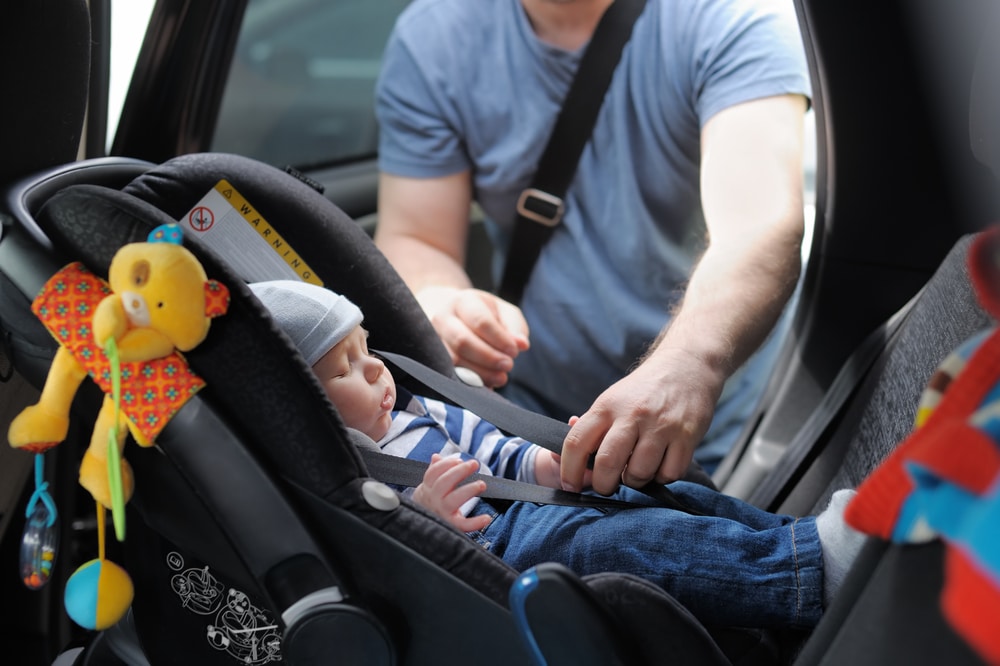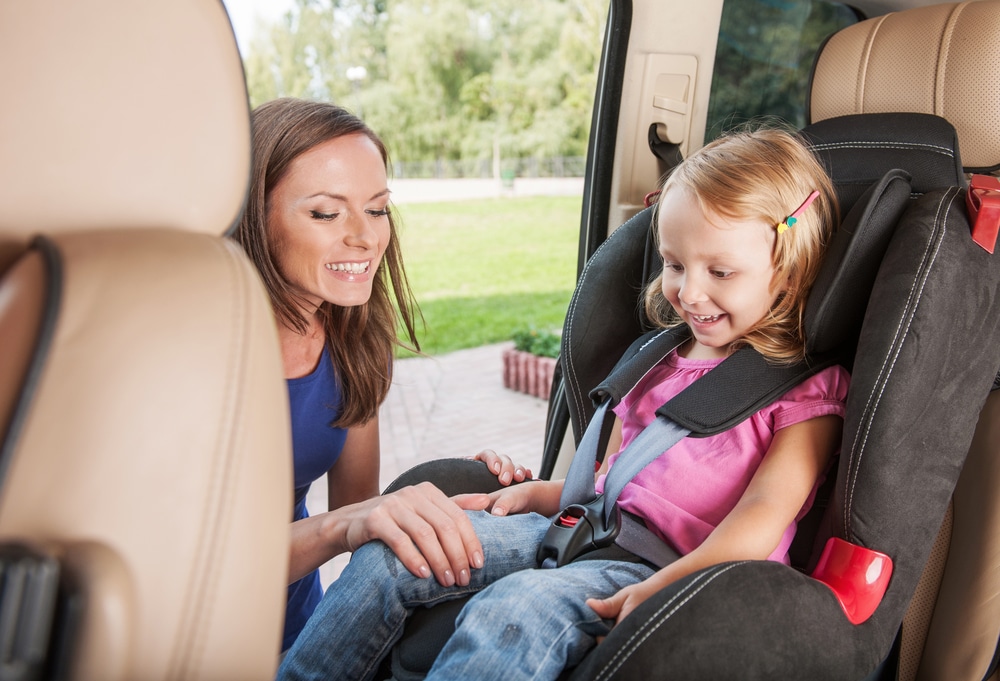Car accidents are the primary cause of accidental deaths in children. One-third of children killed in car accidents were not buckled up properly in car seats, booster seats, or seat belts. Car seats are the most effective way to keep your child safe while out on the road.
Mississippi has enacted laws requiring anyone traveling with children to secure them in safety seats depending on their age, weight, and height. Section 63-7-301 of Motor Vehicles and Traffic Regulations outlines Mississippi seat belt laws, including requirements for children.

Mississippi Car Seat Laws
1. Mississippi Car Seat Laws for Infants and Toddlers

Anyone traveling with a child under four years old in a motor vehicle on a public roadway, street, or highway in Mississippi must secure the child using a child restraint device or system that meets federal motor vehicle safety standards.
Children under two years old must be restrained in a rear-facing only car seat or a rear-facing convertible seat. Drivers must restrain children under four years old in car seats that meet federal motor vehicle safety standards, but they don’t have to be rear-facing. These car seats must be placed in the backseat.
2. Mississippi Car Seat Laws for Young Children

Anyone transporting children between four and seven years old must secure them with a shoulder-positioning booster seat system that meets federal motor vehicle safety standards. Drivers must secure all children under 4’9” tall and those weighing less than 65 pounds in a car seat.
3. Mississippi Laws For Traveling with Two or More Children

Suppose two children required to use booster seats are traveling together in the same vehicle, and the vehicle only has two lap and shoulder belts in the backseat. In that case, only the children seated in the seats with the lap and shoulder belts are required to use a shoulder-positioning booster seat and seatbelt.
Other children traveling in the vehicle can be secured using only a safety seat lap belt on these limited occasions.
When Can Children Sit in the Front Seat?
Mississippi law doesn’t specify when a child can sit in the front seat of a car, although the law states that rear-facing car seats cannot be used in the front seat.
Penalties for Failure to Comply with Mississippi Car Seat Laws
Failure to restrain a child in Mississippi is a misdemeanor punishable by a fine of no more than $25 for each offense. Mississippi does not enter convictions under its car seat laws on a person’s driving record. The state does not impose or collect state assessments for these violations.
See Related State Penalties: Louisiana Car Seat Laws
Exclusions
Under the Mississippi booster seat law, there are some instances when drivers don’t have to secure children in a car seat. In these limited cases, drivers won’t face fines for transporting children without a car seat.
Mississippi law defines passenger motor vehicles as vehicles designed to transport up to 15 people, including drivers. The law excludes all-terrain vehicles, trailers, motorcycles, and autocycles. Buses are also exempt from Mississippi car seat laws.
Registered Farm Vehicles
MS car seat law excludes vehicles registered for farm use, such as “implements of husbandry.” Mississippi law defines implements of husbandry as vehicles made and fitted for exclusive use with horticulture, agriculture, livestock raising operations, or for lifting or carrying husbandry equipment.
Medical Reasons
Mississippi law exempts the use of child restraints when the driver has written verification from a licensed physician that the child cannot be secured in a child seat for safety reasons.
Mississippi Car Seat Recommendations
Although Mississippi seat belt law doesn’t specify what types of car seats drivers should use to secure their children, the Mississippi Department of Health provides detailed guidance about securing children in vehicles.
Safety Tips
Follow these guidelines to safely secure kids traveling in your vehicle.
- Kids in the backseat: All children under 13 years old should not sit in the front seat.
- Always secure kids: Children should not be allowed to ride on a passenger’s lap, truck beds, or cargo spaces.
- Use your weight: To ensure a snug fit between the child seat and the vehicle, use your weight to push the child restraint system into the vehicle seat. At the same time, tighten the seat belt as much as possible.
- Special needs: Some children may need special child seats. Babies born prematurely, kids with breathing problems, skeletal disorders, and neurological and psychiatric problems may require special child seats. Check with your child’s doctor to determine if your child needs to use a special car seat.
- Stay up to date: Use the car’s instruction guide to learn how to use seat belts with car seats properly. The car seat’s user guide and the car’s instruction guide provide information on properly installing car seats.
What Age?
A child’s age isn’t the most important factor when choosing the safest car seat. Car seats should be used until the child outgrows them.
- Use rear-facing car seats until your child exceeds the car seat’s suggested height or weight or at least until they are two years old.
- Use front-facing car seats until your child exceeds the car seat’s suggested height or weight.
- Use booster seats until a child is able to be properly secure in the car’s safety belts or the child is at least 4’9″ tall.
What Type of Car Seat?
The type of car seat you select will depend on the child’s development. Here are some general guidelines to follow.
Infants and Toddlers
Until they are the maximum weight or height outlined by the car seat manufacturer’s guidelines, infants and toddlers should ride in rear-facing only or rear-facing convertible car seats. These are the safest types of car seats for children.
Toddlers and Preschoolers
When children have outgrown rear-facing car seats, they should use convertible car seats or forward-facing seats with a harness until they are the maximum weight or height outlined by the car seat manufacturer’s guidelines. Front-facing child seats with a harness are safer than booster seats.
School-Aged Kids
Once children have outgrown front-facing child seats with a harness, they’re ready to use a belt-positioning booster seat until they can sit safely in a car seat using a regular seatbelt. Children will usually need to grow to at least 4’9” before they’re ready to ride in a car without a booster seat.
Older Kids
When kids have grown enough to be safely secured in a car seat belt, drivers should ensure they use a shoulder seat belt for the best protection. Children under 13 years old should buckle up in the car’s rear seat.
Remember that you should only secure children using federally-authorized cars and booster seats. Never use pillows, towels, books, or other items to boost a child because this could jeopardize their safety.
Final Thoughts
Following Mississippi seat belt laws not only ensures you’re complying with the law, but it also ensures the children traveling with you are safe in the event of an auto accident. Drivers should secure children in the car or booster seats until they’re at least 4’9” tall. Children should ride in the backseat of vehicles until they are at least 13 years old.
Keeping kids buckled up securely in car seats is the most effective way to keep them safe while on the road. If you have additional questions about car seat laws in Mississippi, an attorney can provide you with detailed information. If you have questions about your child’s car seat, consult the owner’s manual, contact the manufacturer directly or ask an expert.






